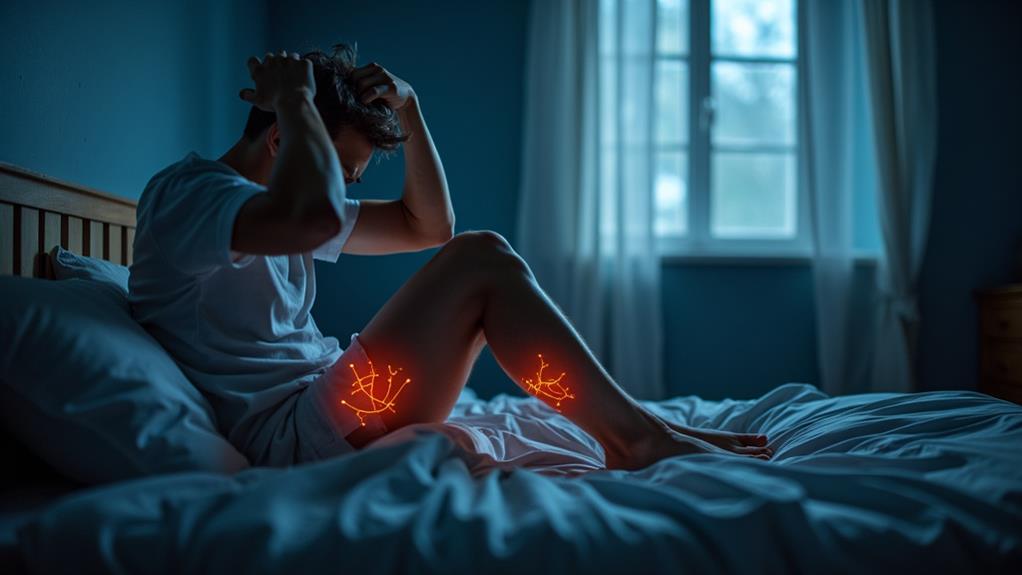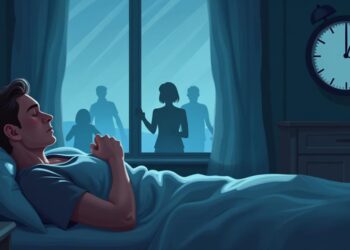If you’ve ever found yourself tossing and turning at night, unable to shake the urge to move your legs, you might be dealing with Restless Leg Syndrome (RLS). This often-overlooked condition can sneak in, disrupting your sleep and leaving you feeling fatigued. Understanding what triggers your symptoms is essential, as it can lead to important lifestyle changes and treatment options. But what if the solutions you think might help are actually missing the mark? Exploring the nuances of RLS could reveal surprising insights about your sleep struggles.
What Is Restless Leg Syndrome?

Restless Leg Syndrome (RLS) is a neurological disorder characterized by an uncontrollable urge to move your legs, often accompanied by uncomfortable sensations. This condition typically worsens during periods of inactivity, especially in the evening or at night, leading to significant disruptions in sleep.
The exact cause of RLS isn’t fully understood, but research suggests a combination of genetic factors and lifestyle influences plays a vital role. If you have a family history of RLS, you’re more likely to develop the disorder yourself, indicating a possible genetic predisposition.
Additionally, certain lifestyle choices can exacerbate symptoms. Factors like lack of physical activity, poor sleep hygiene, and consumption of caffeine or alcohol may contribute to the severity of RLS. Stress and anxiety can also play a role in triggering or worsening symptoms.
Understanding the interplay between genetics and lifestyle influences can help you identify potential risk factors and manage your condition effectively. By making targeted changes, like incorporating regular exercise and improving sleep habits, you may reduce the impact of RLS on your daily life and overall well-being.
Common Symptoms of RLS
People with Restless Leg Syndrome often experience a range of symptoms that can greatly impact their quality of life. One of the most common symptoms is an overwhelming urge to move your legs, especially during periods of inactivity. This sensation is often accompanied by uncomfortable feelings, described as itching, tingling, or aching.
You might notice these symptoms become more pronounced in the evening, making it difficult to relax or fall asleep.
Some RLS triggers include prolonged sitting, stress, caffeine, and certain medications. Recognizing these triggers can help you manage your symptoms more effectively.
However, it’s important to address common RLS myths, such as the belief that it’s merely a psychological issue or that it only affects older adults. RLS can impact anyone, regardless of age or mental health status.
Another symptom you may encounter is periodic limb movements during sleep, which can disrupt your sleep cycle and lead to daytime fatigue. Understanding these symptoms is essential for seeking effective treatment options and improving your overall well-being.
If you suspect you have RLS, consult a healthcare professional for an accurate diagnosis and personalized management plan.
Understanding the Causes
Understanding the causes of Restless Leg Syndrome (RLS) involves exploring a variety of factors, including genetic predispositions, neurological issues, and underlying medical conditions.
Research indicates that you may have a genetic predisposition to RLS, making it run in families. This hereditary component suggests that if someone in your family has RLS, you might be at higher risk.
Iron deficiency is another significant contributor; low iron levels can affect dopamine function, leading to discomfort in your legs.
Additionally, a neurotransmitter imbalance, particularly involving dopamine, plays an important role in the development of RLS symptoms.
Chronic conditions such as diabetes, kidney disease, and peripheral neuropathy can exacerbate RLS, as they impact nerve function and overall health.
You might also experience symptoms triggered by environmental factors, like prolonged inactivity or exposure to certain medications.
Hormonal changes, particularly during pregnancy, can also heighten your chances of experiencing RLS.
Understanding these causes can help you identify potential triggers and work with your healthcare provider to develop effective management strategies.
Risk Factors for RLS
What factors might increase your risk for developing Restless Leg Syndrome (RLS)?
First, a genetic predisposition plays a significant role. If you have family members with RLS, your chances of developing it rise. This hereditary aspect indicates that your genes may influence how your brain processes dopamine, a neurotransmitter critical to movement control.
Lifestyle influences also contribute to your risk. Sedentary habits, such as prolonged sitting or lack of physical activity, can exacerbate symptoms. Additionally, certain dietary choices, particularly low iron intake, may trigger or worsen RLS.
If you consume excessive caffeine or alcohol, you could find your symptoms intensifying, as these substances can disrupt sleep patterns and enhance restlessness.
Certain medical conditions, including diabetes and peripheral neuropathy, may also increase your susceptibility to RLS. Hormonal changes during pregnancy or menopause can heighten your risk as well.
Finally, medications, such as antihistamines and antidepressants, might provoke RLS symptoms, further complicating your situation.
Understanding these risk factors can help you take proactive steps to manage or reduce the likelihood of developing RLS. By addressing lifestyle influences and being aware of your genetic background, you can better navigate this condition.
Diagnosis and Medical Evaluation
Recognizing the risk factors for Restless Leg Syndrome (RLS) is just the first step; a proper diagnosis is essential for effective management. To diagnose RLS, healthcare providers rely on specific diagnostic criteria established by the International Restless Legs Syndrome Study Group. These criteria include an overwhelming urge to move the legs, worsening symptoms during periods of inactivity, relief through movement, and symptoms occurring primarily in the evening or night.
Your medical history plays a significant role in this evaluation. Be prepared to discuss any family history of RLS, as genetics can be a contributing factor. Additionally, your doctor will inquire about any medications you’re taking, as certain drugs can exacerbate symptoms.
It’s also important to mention any underlying health conditions, such as iron deficiency or neuropathy, that may influence your symptoms. Once your healthcare provider evaluates your symptoms and medical history, they may recommend further tests, like blood tests, to rule out other conditions.
This thorough approach helps guarantee an accurate diagnosis, paving the way for effective treatment options tailored to your specific needs.
Lifestyle Changes for Relief
Making lifestyle changes can greatly alleviate the symptoms of Restless Leg Syndrome (RLS). By implementing specific strategies, you can enhance your comfort and improve your sleep hygiene. Here are four effective adjustments to contemplate:
- Dietary Adjustments: Focus on a balanced diet rich in iron, magnesium, and folate. Reducing caffeine intake can also minimize symptoms, so contemplate cutting back on coffee and soda.
- Exercise Routines: Regular physical activity can help manage RLS symptoms. Aim for low-impact exercises like walking, swimming, or yoga, which promote blood circulation and relieve tension.
- Stress Management: Stress can exacerbate RLS, so incorporating relaxation techniques such as mindfulness, meditation, or deep breathing exercises can be beneficial.
- Warm Baths and Leg Massages: Taking warm baths before bedtime can relax your muscles. Additionally, gentle leg massages can improve circulation and alleviate discomfort.
Treatment Options Available

While lifestyle changes can provide significant relief for Restless Leg Syndrome (RLS), medication and other treatment options may be necessary for more severe cases. If you’re experiencing persistent symptoms, it’s essential to consult a healthcare professional to explore appropriate medication options. Common prescriptions include dopaminergic agents, which increase dopamine levels in your brain, helping to reduce sensations in your legs.
Other options may involve anticonvulsants or opioids, which can alleviate severe discomfort.
In addition to medication, you might consider alternative therapies. Techniques such as acupuncture, massage, and yoga have shown promise in managing RLS symptoms. Some individuals find relief through iron supplementation, especially if blood tests indicate low iron levels.
You should also explore lifestyle modifications that complement these treatments, such as regular exercise and maintaining a sleep schedule.
However, it’s important to recognize that everyone’s experience with RLS is unique, so what works for one person may not work for another. Engaging in open discussions with your healthcare provider will help tailor a personalized treatment plan, ensuring you find the best approach to manage your symptoms effectively.
Coping Strategies for Better Sleep
Getting a good night’s sleep can be challenging for those with Restless Leg Syndrome (RLS). However, implementing effective coping strategies can greatly improve your sleep quality. Focus on maintaining good sleep hygiene and incorporating relaxation techniques into your routine.
Here are four strategies to help you:
- Establish a Sleep Schedule: Go to bed and wake up at the same time every day. Consistency reinforces your body’s natural sleep-wake cycle.
- Create a Relaxing Bedtime Routine: Engage in calming activities before bedtime, such as reading or meditation. This helps signal to your body that it’s time to wind down.
- Limit Stimulants: Avoid caffeine and nicotine, especially in the evening. These substances can exacerbate RLS symptoms and disrupt your sleep.
- Incorporate Stretching or Light Exercise: Gentle stretching or low-impact exercises can alleviate RLS symptoms. Aim for at least 30 minutes of activity during the day.
Conclusion
To summarize, Restless Leg Syndrome can greatly disrupt your sleep and daily life, but understanding your symptoms and causes is key. For instance, consider Jane, a 35-year-old teacher who struggled with nightly leg discomfort. After identifying her iron deficiency and making lifestyle adjustments, she saw remarkable improvements. By seeking medical evaluation and employing coping strategies, you too can reclaim restful nights and enhance your overall well-being. Don’t let RLS be your hidden sleep thief any longer.














